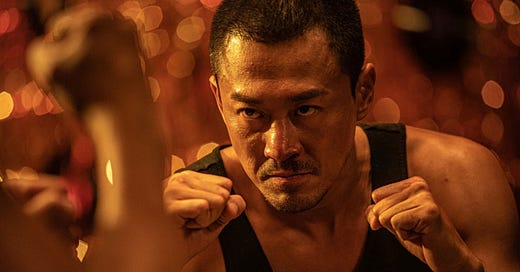Review: Twilight of the Warriors: Walled In
Times are Rough, Being in a Martial Arts Movie is Rougher
There seems to be a meta aspect to the title, Twilight of the Warriors: Walled In. The film is set in Hong Kong in the 80’s, a time when the likes of Jet Li and Jackie Chan were re-inventing the martial arts film. It’s clear that director Soi Cheang wants to harken back to the heyday of that genre, and the environs that generated it, particularly the bustle of a former colony looking nervously to the day when it would come under Chinese control.
It’s an epic tale Cheang is telling, about a refugee, Lok (Raymond Lam), who escapes with a bag full of Triad drugs into the Kowloon Walled City – a dark, decaying tangle of concrete buildings rarely kissed by daylight, operating under its own, laissez-faire governing system. He’s taken in by Cyclone (Louis Koo), the city’s de facto security supervisor and resident barber – gotta keep the lights on somehow – and recruited into the local street gang, a group of puppy dog adorable enforcers who love nothing more than whiling away their time playing mahjong, when they aren’t kicking the holy shit out of woman beaters.
And when I say shit gets kicked, I’m not minimizing things. It’s been a while since I’ve watched a full-on wuxia film, so I don’t know if the level of violence in the genre has been amplified over time, or if fight choreographer Kenji Tanigaki is blazing new trails, but the fight sequences in this film are some of the most brutal I’ve ever witnessed. It’s not unusual for martial arts characters to endure exaggerated physical punishments, but it’s hard to imagine any real human undergoing the kinds of assaults the protagonists of Twilight of the Warriors do without being reduced to a sack of bloody pulp. I typically get quickly bored with unremitting, unrestrained mayhem – it gets tedious after a while – but Tanigaki masterfully orchestrates each of the copious action sequences with creative camerawork, cutting, and lots of Jackie Chan-style location-based choreography. The stuff feels more exhilarating than exhausting.
Cheang backs the action up with an elaborate tale of crime and vengeance, one that eventually ropes in Lok in a surprising way (but not too surprising, I know how these stories are told). Given the meta narrative, I was kind-of expecting more of an Ip Man experience, with numerous legends of martial arts showing up to pay tribute to their glory days, but no, only Sammo Hung is here to represent, as a Triad boss. That’s not a big deal – Twilight of Warriors: Walled In on its own is a violently delightful invocation of action film indulgence, and a thrill from start to end.






There is a documentary on Youtube about mapping the Kowloon walled city, it is very good!